DEFENITION OF INVESTMENT Investment is putting money

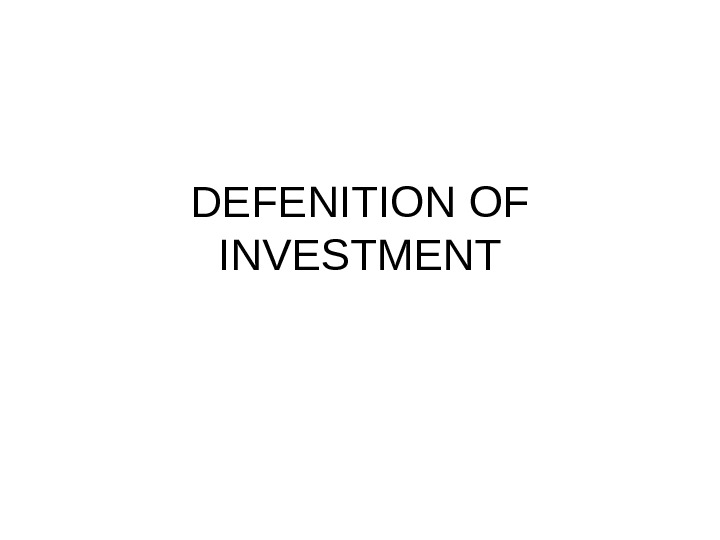

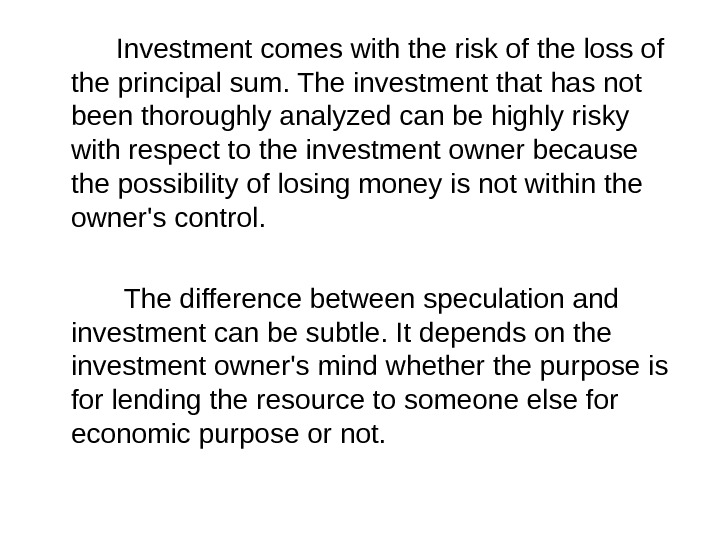
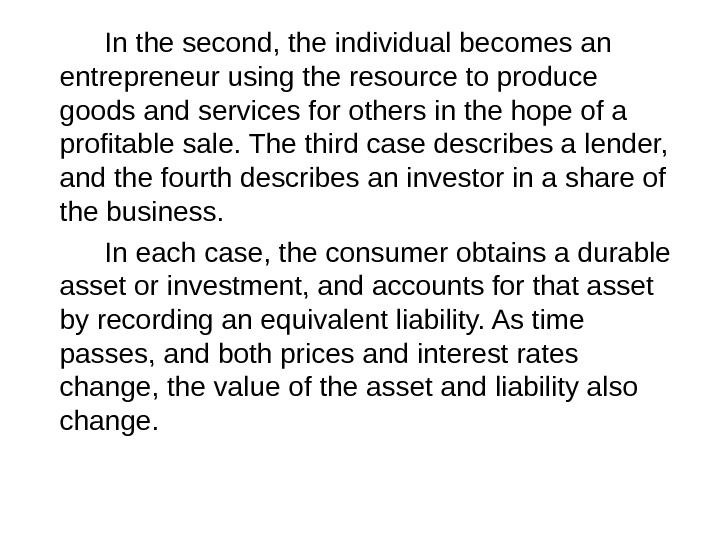
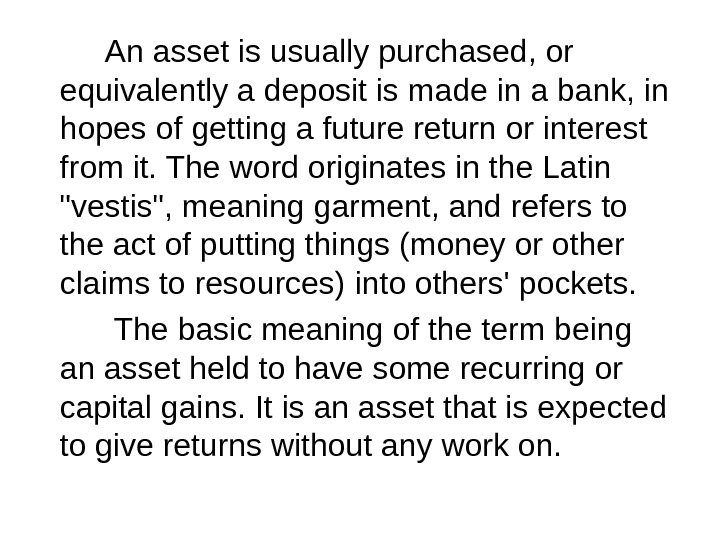
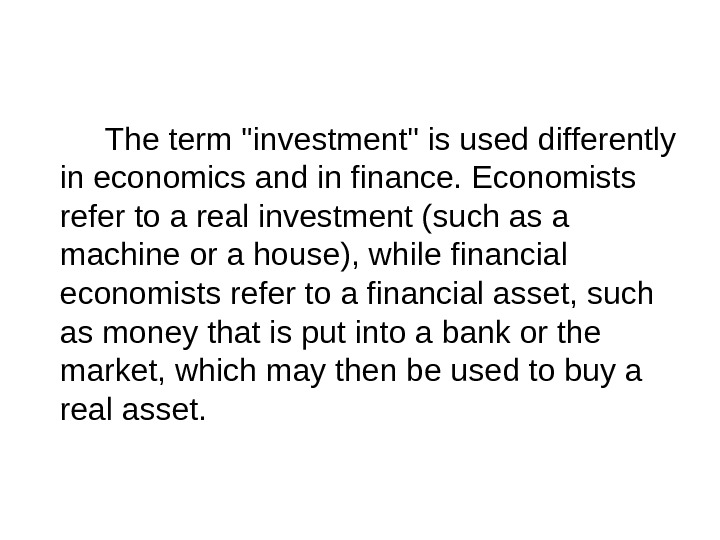

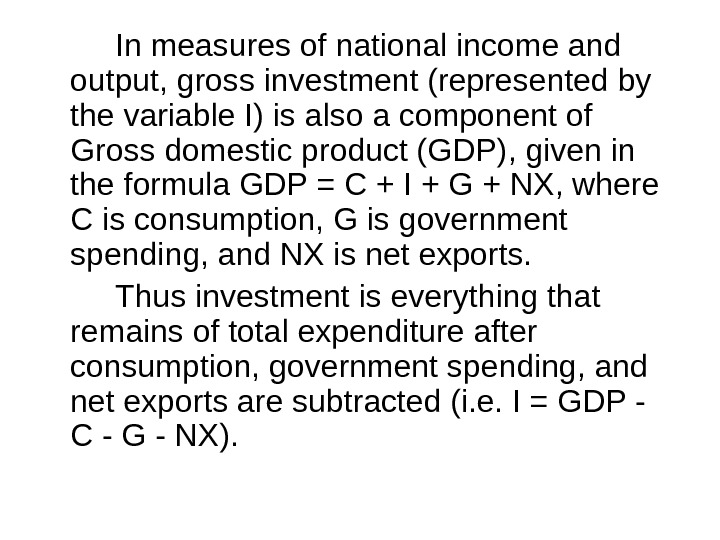
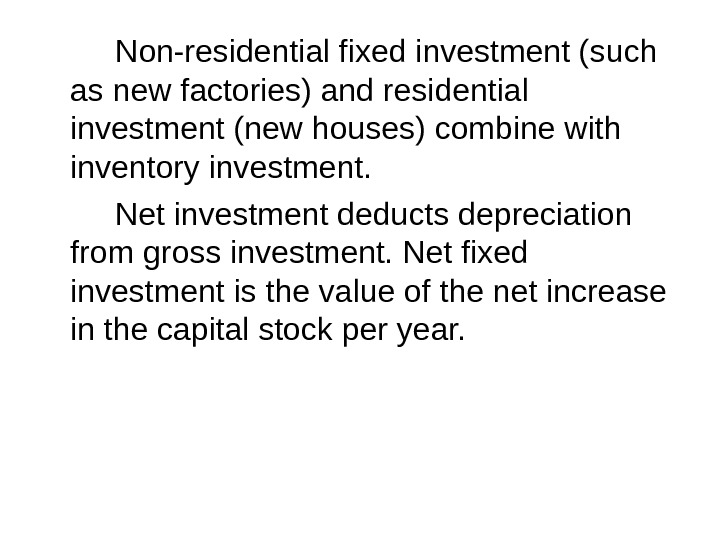
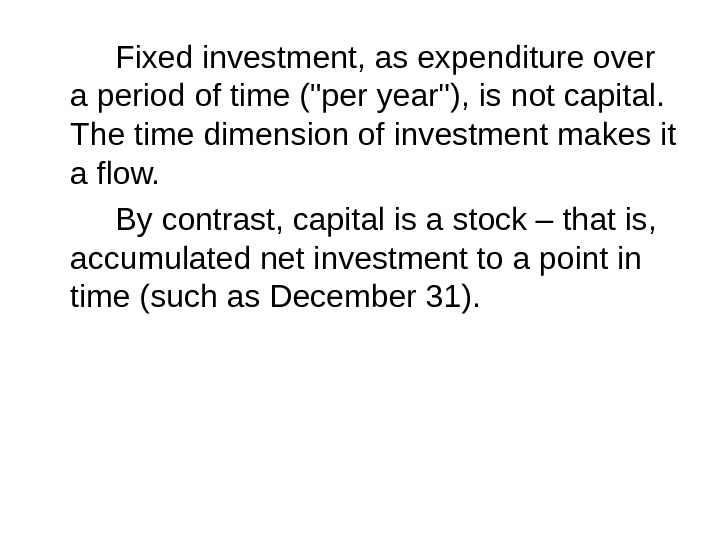
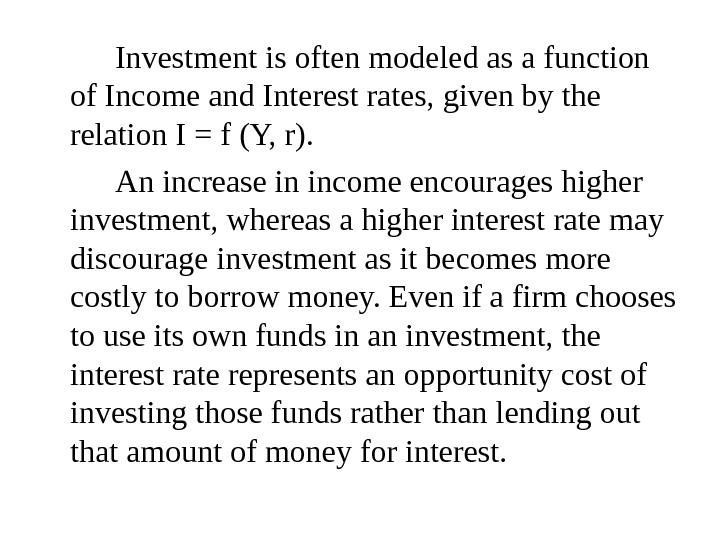
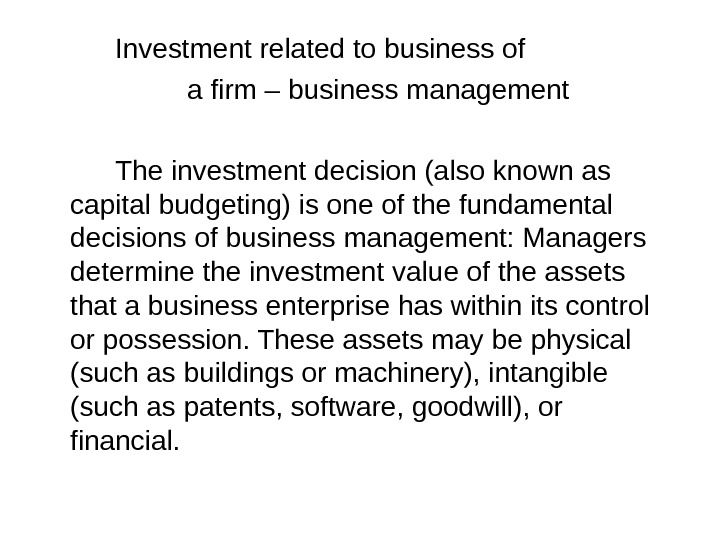
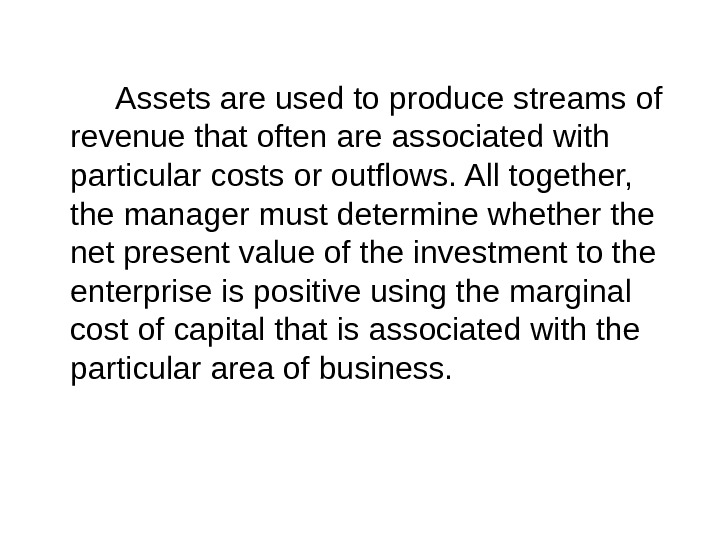
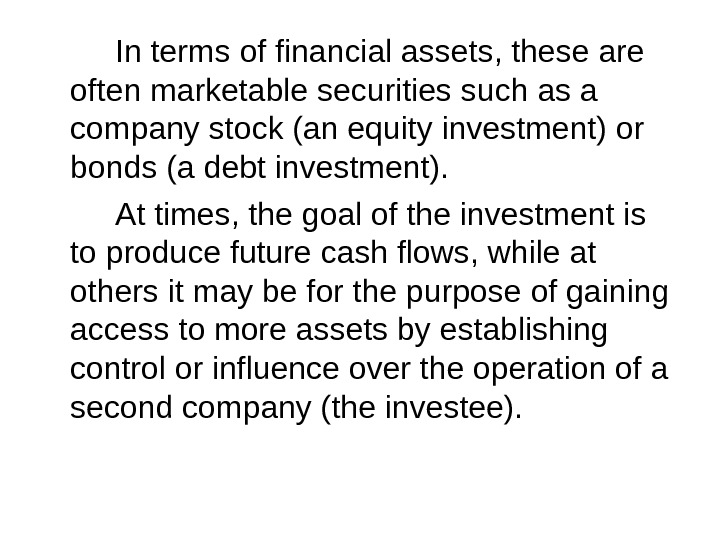
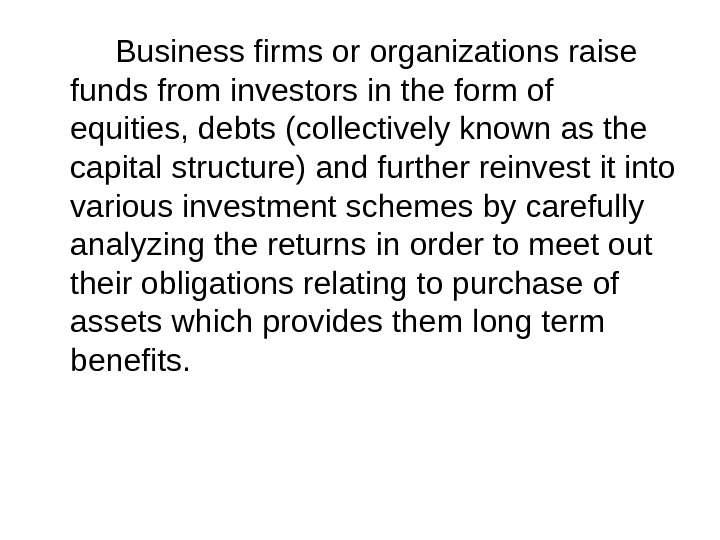
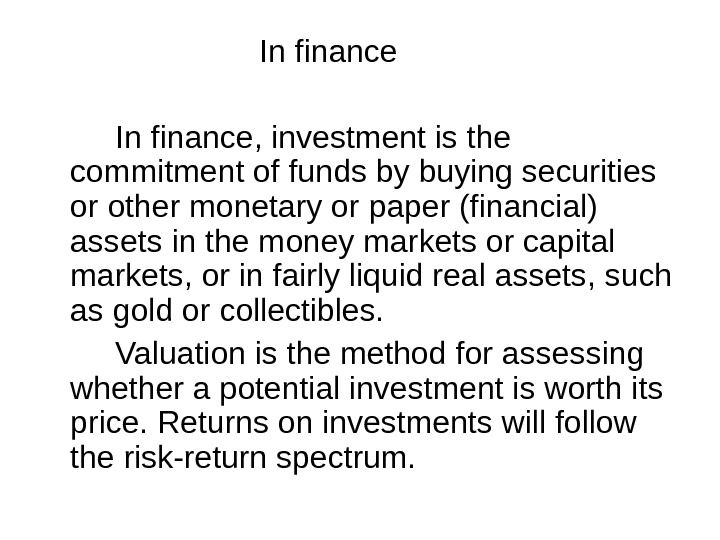
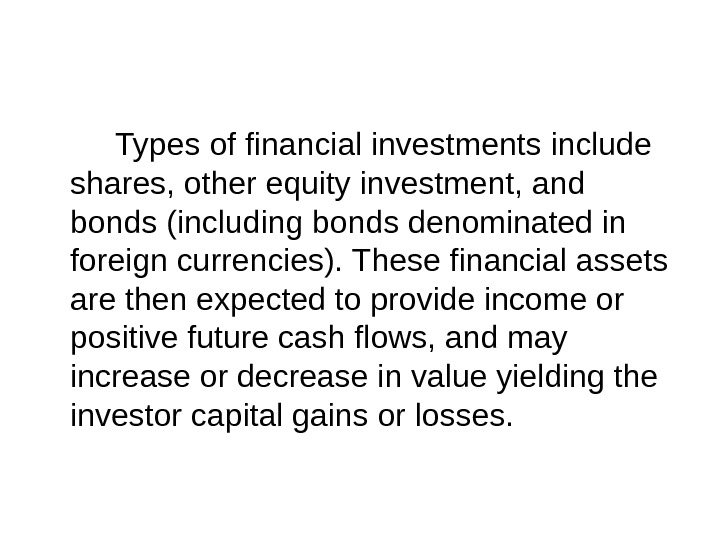
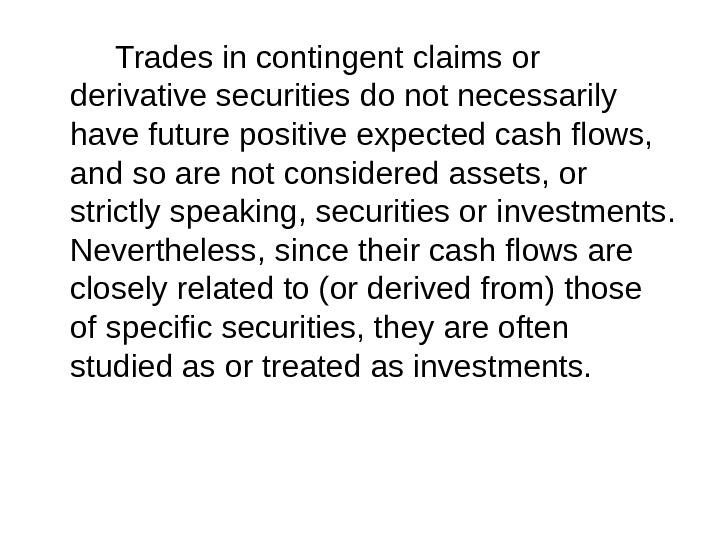
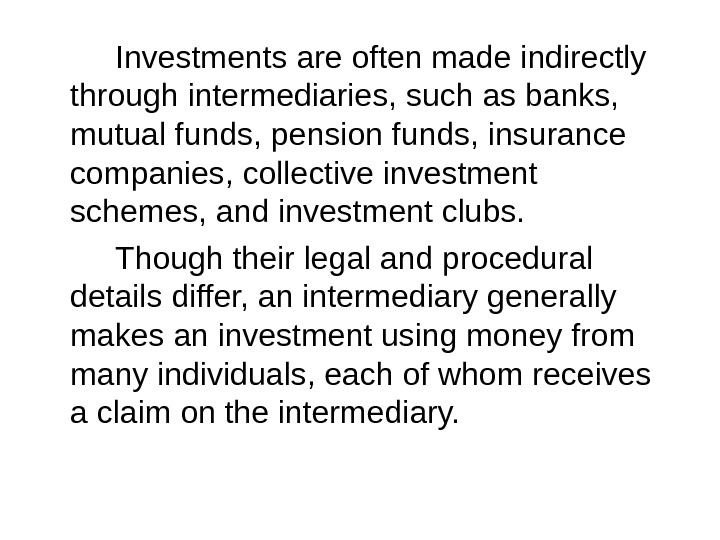
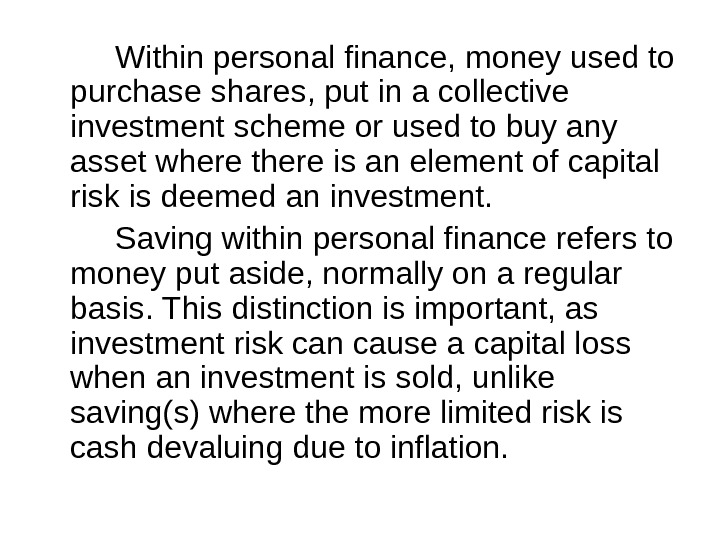
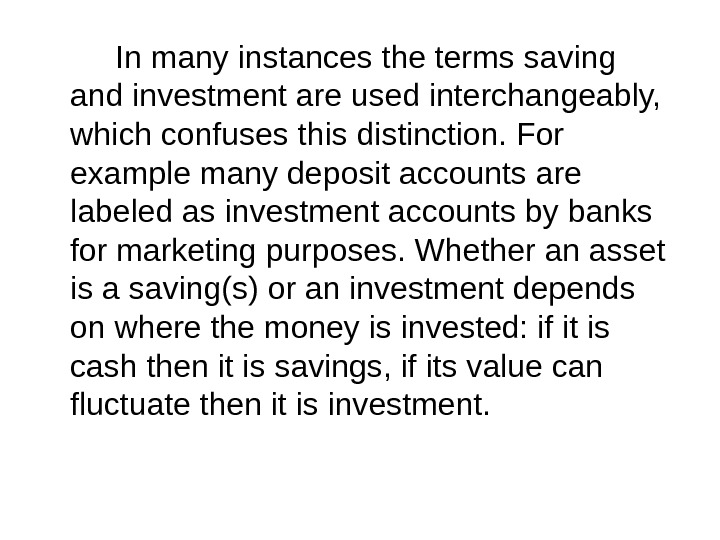
1_defenition_of_investment.ppt
- Размер: 58.5 Кб
- Количество слайдов: 21
Описание презентации DEFENITION OF INVESTMENT Investment is putting money по слайдам
 DEFENITION OF INVESTMENT
DEFENITION OF INVESTMENT
 Investment is putting money into something with the expectation of profit. More specifically, investment is the commitment of money or capital to the purchase of financial instruments or other assets so as to gain profitable returns in the form of interest, dividends, or appreciation of the value of the instrument (capital gains). It is related to saving or deferring consumption. Investment is involved in many areas of the economy, such as business management and finance no matter for households, firms, or governments.
Investment is putting money into something with the expectation of profit. More specifically, investment is the commitment of money or capital to the purchase of financial instruments or other assets so as to gain profitable returns in the form of interest, dividends, or appreciation of the value of the instrument (capital gains). It is related to saving or deferring consumption. Investment is involved in many areas of the economy, such as business management and finance no matter for households, firms, or governments.
 Investment comes with the risk of the loss of the principal sum. The investment that has not been thoroughly analyzed can be highly risky with respect to the investment owner because the possibility of losing money is not within the owner’s control. The difference between speculation and investment can be subtle. It depends on the investment owner’s mind whether the purpose is for lending the resource to someone else for economic purpose or not.
Investment comes with the risk of the loss of the principal sum. The investment that has not been thoroughly analyzed can be highly risky with respect to the investment owner because the possibility of losing money is not within the owner’s control. The difference between speculation and investment can be subtle. It depends on the investment owner’s mind whether the purpose is for lending the resource to someone else for economic purpose or not.
 In the second, the individual becomes an entrepreneur using the resource to produce goods and services for others in the hope of a profitable sale. The third case describes a lender, and the fourth describes an investor in a share of the business. In each case, the consumer obtains a durable asset or investment, and accounts for that asset by recording an equivalent liability. As time passes, and both prices and interest rates change, the value of the asset and liability also change.
In the second, the individual becomes an entrepreneur using the resource to produce goods and services for others in the hope of a profitable sale. The third case describes a lender, and the fourth describes an investor in a share of the business. In each case, the consumer obtains a durable asset or investment, and accounts for that asset by recording an equivalent liability. As time passes, and both prices and interest rates change, the value of the asset and liability also change.
 An asset is usually purchased, or equivalently a deposit is made in a bank, in hopes of getting a future return or interest from it. The word originates in the Latin «vestis», meaning garment, and refers to the act of putting things (money or other claims to resources) into others’ pockets. The basic meaning of the term being an asset held to have some recurring or capital gains. It is an asset that is expected to give returns without any work on.
An asset is usually purchased, or equivalently a deposit is made in a bank, in hopes of getting a future return or interest from it. The word originates in the Latin «vestis», meaning garment, and refers to the act of putting things (money or other claims to resources) into others’ pockets. The basic meaning of the term being an asset held to have some recurring or capital gains. It is an asset that is expected to give returns without any work on.
 The term «investment» is used differently in economics and in finance. Economists refer to a real investment (such as a machine or a house), while financial economists refer to a financial asset, such as money that is put into a bank or the market, which may then be used to buy a real asset.
The term «investment» is used differently in economics and in finance. Economists refer to a real investment (such as a machine or a house), while financial economists refer to a financial asset, such as money that is put into a bank or the market, which may then be used to buy a real asset.
 In economics or macroeconomics In economic theory or in macroeconomics, investment is the amount purchased per unit time of goods which are not consumed but are to be used for future production. Examples include railroad or factory construction. Investment in human capital includes costs of additional schooling or on-the-job training. Inventory investment refers to the accumulation of goods inventories; it can be positive or negative, and it can be intended or unintended.
In economics or macroeconomics In economic theory or in macroeconomics, investment is the amount purchased per unit time of goods which are not consumed but are to be used for future production. Examples include railroad or factory construction. Investment in human capital includes costs of additional schooling or on-the-job training. Inventory investment refers to the accumulation of goods inventories; it can be positive or negative, and it can be intended or unintended.
 In measures of national income and output, gross investment (represented by the variable I) is also a component of Gross domestic product (GDP), given in the formula GDP = C + I + G + NX, where C is consumption, G is government spending, and NX is net exports. Thus investment is everything that remains of total expenditure after consumption, government spending, and net exports are subtracted (i. e. I = GDP — C — G — NX).
In measures of national income and output, gross investment (represented by the variable I) is also a component of Gross domestic product (GDP), given in the formula GDP = C + I + G + NX, where C is consumption, G is government spending, and NX is net exports. Thus investment is everything that remains of total expenditure after consumption, government spending, and net exports are subtracted (i. e. I = GDP — C — G — NX).
 Non-residential fixed investment (such as new factories) and residential investment (new houses) combine with inventory investment. Net investment deducts depreciation from gross investment. Net fixed investment is the value of the net increase in the capital stock per year.
Non-residential fixed investment (such as new factories) and residential investment (new houses) combine with inventory investment. Net investment deducts depreciation from gross investment. Net fixed investment is the value of the net increase in the capital stock per year.
 Fixed investment, as expenditure over a period of time («per year»), is not capital. The time dimension of investment makes it a flow. By contrast, capital is a stock – that is, accumulated net investment to a point in time (such as December 31).
Fixed investment, as expenditure over a period of time («per year»), is not capital. The time dimension of investment makes it a flow. By contrast, capital is a stock – that is, accumulated net investment to a point in time (such as December 31).
 Investment is often modeled as a function of Income and Interest rates, given by the relation I = f (Y, r). An increase in income encourages higher investment, whereas a higher interest rate may discourage investment as it becomes more costly to borrow money. Even if a firm chooses to use its own funds in an investment, the interest rate represents an opportunity cost of investing those funds rather than lending out that amount of money for interest.
Investment is often modeled as a function of Income and Interest rates, given by the relation I = f (Y, r). An increase in income encourages higher investment, whereas a higher interest rate may discourage investment as it becomes more costly to borrow money. Even if a firm chooses to use its own funds in an investment, the interest rate represents an opportunity cost of investing those funds rather than lending out that amount of money for interest.
 Investment related to business of a firm – business management The investment decision (also known as capital budgeting) is one of the fundamental decisions of business management: Managers determine the investment value of the assets that a business enterprise has within its control or possession. These assets may be physical (such as buildings or machinery), intangible (such as patents, software, goodwill), or financial.
Investment related to business of a firm – business management The investment decision (also known as capital budgeting) is one of the fundamental decisions of business management: Managers determine the investment value of the assets that a business enterprise has within its control or possession. These assets may be physical (such as buildings or machinery), intangible (such as patents, software, goodwill), or financial.
 Assets are used to produce streams of revenue that often are associated with particular costs or outflows. All together, the manager must determine whether the net present value of the investment to the enterprise is positive using the marginal cost of capital that is associated with the particular area of business.
Assets are used to produce streams of revenue that often are associated with particular costs or outflows. All together, the manager must determine whether the net present value of the investment to the enterprise is positive using the marginal cost of capital that is associated with the particular area of business.
 In terms of financial assets, these are often marketable securities such as a company stock (an equity investment) or bonds (a debt investment). At times, the goal of the investment is to produce future cash flows, while at others it may be for the purpose of gaining access to more assets by establishing control or influence over the operation of a second company (the investee).
In terms of financial assets, these are often marketable securities such as a company stock (an equity investment) or bonds (a debt investment). At times, the goal of the investment is to produce future cash flows, while at others it may be for the purpose of gaining access to more assets by establishing control or influence over the operation of a second company (the investee).
 Business firms or organizations raise funds from investors in the form of equities, debts (collectively known as the capital structure) and further reinvest it into various investment schemes by carefully analyzing the returns in order to meet out their obligations relating to purchase of assets which provides them long term benefits.
Business firms or organizations raise funds from investors in the form of equities, debts (collectively known as the capital structure) and further reinvest it into various investment schemes by carefully analyzing the returns in order to meet out their obligations relating to purchase of assets which provides them long term benefits.
 In finance, investment is the commitment of funds by buying securities or other monetary or paper (financial) assets in the money markets or capital markets, or in fairly liquid real assets, such as gold or collectibles. Valuation is the method for assessing whether a potential investment is worth its price. Returns on investments will follow the risk-return spectrum.
In finance, investment is the commitment of funds by buying securities or other monetary or paper (financial) assets in the money markets or capital markets, or in fairly liquid real assets, such as gold or collectibles. Valuation is the method for assessing whether a potential investment is worth its price. Returns on investments will follow the risk-return spectrum.
 Types of financial investments include shares, other equity investment, and bonds (including bonds denominated in foreign currencies). These financial assets are then expected to provide income or positive future cash flows, and may increase or decrease in value yielding the investor capital gains or losses.
Types of financial investments include shares, other equity investment, and bonds (including bonds denominated in foreign currencies). These financial assets are then expected to provide income or positive future cash flows, and may increase or decrease in value yielding the investor capital gains or losses.
 Trades in contingent claims or derivative securities do not necessarily have future positive expected cash flows, and so are not considered assets, or strictly speaking, securities or investments. Nevertheless, since their cash flows are closely related to (or derived from) those of specific securities, they are often studied as or treated as investments.
Trades in contingent claims or derivative securities do not necessarily have future positive expected cash flows, and so are not considered assets, or strictly speaking, securities or investments. Nevertheless, since their cash flows are closely related to (or derived from) those of specific securities, they are often studied as or treated as investments.
 Investments are often made indirectly through intermediaries, such as banks, mutual funds, pension funds, insurance companies, collective investment schemes, and investment clubs. Though their legal and procedural details differ, an intermediary generally makes an investment using money from many individuals, each of whom receives a claim on the intermediary.
Investments are often made indirectly through intermediaries, such as banks, mutual funds, pension funds, insurance companies, collective investment schemes, and investment clubs. Though their legal and procedural details differ, an intermediary generally makes an investment using money from many individuals, each of whom receives a claim on the intermediary.
 Within personal finance, money used to purchase shares, put in a collective investment scheme or used to buy any asset where there is an element of capital risk is deemed an investment. Saving within personal finance refers to money put aside, normally on a regular basis. This distinction is important, as investment risk can cause a capital loss when an investment is sold, unlike saving(s) where the more limited risk is cash devaluing due to inflation.
Within personal finance, money used to purchase shares, put in a collective investment scheme or used to buy any asset where there is an element of capital risk is deemed an investment. Saving within personal finance refers to money put aside, normally on a regular basis. This distinction is important, as investment risk can cause a capital loss when an investment is sold, unlike saving(s) where the more limited risk is cash devaluing due to inflation.
 In many instances the terms saving and investment are used interchangeably, which confuses this distinction. For example many deposit accounts are labeled as investment accounts by banks for marketing purposes. Whether an asset is a saving(s) or an investment depends on where the money is invested: if it is cash then it is savings, if its value can fluctuate then it is investment.
In many instances the terms saving and investment are used interchangeably, which confuses this distinction. For example many deposit accounts are labeled as investment accounts by banks for marketing purposes. Whether an asset is a saving(s) or an investment depends on where the money is invested: if it is cash then it is savings, if its value can fluctuate then it is investment.

